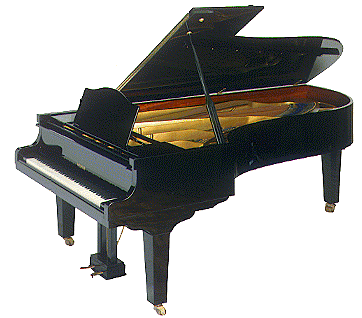What is the piano?
What is the piano?: The piano is a musical instrument considered as an evolution that are involved in other instruments. It is classified as a keyboard instrument with swinging strings and more recently as a sounding board zither and keyboard added that the strings are struck. The name of the instrument is actually short for "pianoforte", referring to the instrument's ability to deliver the sound with different levels of intensity or volume (piano = soft, forte = strong), depending on how hard the key actions , which at the time of its creation was a revolutionary concept.
As the piano the result of a constant evolution, history depends on the instruments that compose it and the oldest of them is the zither. The story speculates piano originates in Africa and Southeast Asia in the Bronze Age, 3000 BC It was a group of cords laid at height on a small table. Were used to make them sound the fingernails or a sharp object. After the zither, the next instrument in the way the piano is the Psalter, which was built as the trapezoidal zither but so that all ropes had one length. It consisted of a tonal soundboard with bridges. Those instruments reaches the harpsichord, with the idea that the strings do not touch with your fingers, but with a mechanical system consisting of a metal spike that was driven by a keyboard played with the fingers. By 1695, Bartolomeo Cristofori began designing the first piano, based on the model of the harpsichord. The latter emitted a metallic sound so Cristofori designed a piece of wood tipped hammer percudiera leather cords, this gave the instrument a much sweeter sound. The pianos later, with many improvements have been based on the piano Critófori up to modern pianos.
As for modern pianos there are two groups: the pianos and grand pianos. The upright piano is made up of harp, strings and hammers, all perpendicular to the floor leaving the instrument as a standing furniture. The grand piano is composed of the harp, strings and hammers, but parallel to the floor, leaving a cabinet shaped tail lying on its back.
The two types of pianos are fitted with pedals that cause effects on the instrument's sound. In the case of the grand piano, has left pedal, used to make two ropes hitting with a hammer and a third strand to vibrate causing sound sweeter, or tonal center pedal, causing the same note or chord is maintained for a time without being affected by them touch after, finally, the sustain pedal, causing a note to continue sounding even having released a key other strings vibrate and increase the sound volume. On the upright piano, the left pedal serves to bring the hammer to the strings so that by striking decrease the sound volume, the center pedal called damper, which serves to reduce the play without disturbing allowing sound; finally the pedal resonance, which has the same functions as the grand piano.
Some of the most outstanding pianists of all times are María Teresa Carreño (Venezuela, 1853-1917), Ignacy Jan Paderewski (Poland, 1860-1941), Alfred Cortot (French, 1877-1962), Arthur Rubinstein (Poland, 1887 - 1982), Myra Hess (Britain, 1890-1965), Walter Gieseking (Germany, 1895-1956), Wilhelm Kempff (Germany, 1895-1991), Guiomar Novaes (Brazil, 1896-1979), Claudio Arrau (Chile, 1903 -1991), Vladimir Horowitz (Russian, 1903-1989), Rudolf Serkin (Austria, 1903-1991), Sviatoslav Richter (Ukraine, 1915-1997), Emil Gilels (Ukraine, 1916-1985), Alice Garrocha (Spain, 1923), Alfred Brendel (Austria, 1931), Glenn Gould (Canadian, 1932-1982), Vladimir Ashkenazy (Russia, 1937), Martha Argerich (Argentina, 1941), Daniel Barenboim (Israel, 1942) and Murray Perahia (USA, 1947), among other outstanding interpreters of the piano.
What is the piano? 2012

0 comentarios:
Publicar un comentario